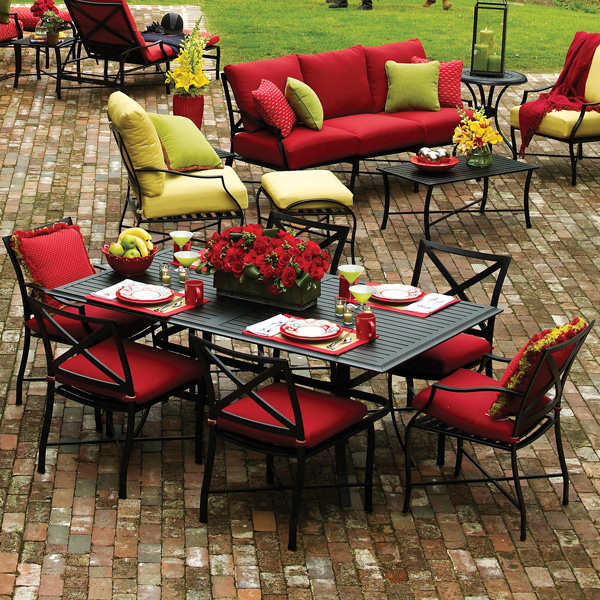Make the most of your outdoor space with furniture that complements your favorite open-air activities. Consider these things before buying your outdoor furniture:
- Is the furniture appropriately scaled to the outdoor area where it will be used? A small patio or deck can be dwarfed by large furniture groupings. Conversely, a spacious deck looks best with a larger grouping.
- Will the furniture seat the required number of people? Consider who will typically use the furniture. If you plan on entertaining large groups, stackable metal or resin chairs store in a small space, ready for that garden party or family reunion.
- Do the styles and colors of the furniture blend with your home? Treat your deck or patio as you would any other room in your home when decorating. Outdoor furniture is available in many styles from rustic to modern. Choose from cushions with colors as vivid or subdued as you like.
There are four main types of furniture to consider: wood, metal, wicker, and recycled plastic. This guide describes the advantages of each and what to look for.
WOOD
Everything from simple pine to luxurious teak is used to manufacture wood patio furniture. Dissimilar types of wood perform very differently and you should always take this into consideration if you are contemplating the purchase of wood patio furniture. Softer woods (those products harvested from needle-bearing trees) are going to weather quickly and will require annual maintenance. Harder wood (those harvested from broad leaf trees) will last longer and not require as much attention.
If your wood patio furniture will be in a sun room or covered area, this isn’t an issue. Soft woods such as pine, cypress, and redwood will be fine. However, if you plan to use your wooden furniture where it will be exposed to the elements, you should shop for a hardwood. These are traditionally Brazilian Cherry, Jarrah, and Teak.
Teak furniture tends to be the most expensive to purchase, however it may be worth the extra dollars. Teak is one of the hardest woods available, which means it is impervious to insect damage. It won’t rot or splinter, and it requires no special treatment if it is going to be exposed to rain and sun. New teak has a rich, buttery honey colour and will maintain this look if you simply apply linseed oil to it once or twice a year. If left alone, teak will weather to a silvery grey finish.
METAL
Metals commonly used for outdoor furniture are aluminum, iron, and steel. Wrought iron and steel furniture are basically the same; wrought iron is a low carbon form of steel. Both tend to be budget-friendly, though high end, designer wrought iron furniture is also available. As both types take abuse very well, they should survive heavy usage. This furniture is weighty and perfect for windy locations.
Modern manufacturing techniques include a zinc wash to inhibit the formation of rust, eliminating concern and objection to this material. If rust does occur, you can simply sand and spray paint the affected area and it will be as good as new. Slight rusting does not compromise the integrity of the frames.
Cast aluminum furniture is made by pouring molten aluminum into molds of different shapes that are then assembled to create the furniture, resulting in a beautiful, heavy, weather-resistant product. Cast aluminum is very durable and requires very little maintenance, making it extremely popular for all budgets. It has no rust issues and being a heavy material it is perfect for areas where wind is a concern.
Extruded aluminum is generally combined with “sling” fabric to produce maintenance free, comfortable outdoor seating. Extrusion is the process of shaping material by forcing it through a die. The shapes are combined to created frames for chairs and tables, resulting in a lighter less cumbersome frame than cast aluminum that still maintains the weather resistant properties.
Cast aluminum and extruded aluminum elements can often be found in the same furniture
WICKER
Having undergone a revolution in the past several years, wicker and rattan furniture can be found in its traditional form, as well as the newer, popular synthetic option. Available in classic weaves and styles; it is also manufactured in a wide variety of modern weaves and styles, thus having the ability to be implemented into any décor.
Traditional wicker is usually rattan, but may be woven of other natural materials. Suitable for indoor or covered areas, it will weather and require some care if it is exposed to the elements. Synthetic wicker is impervious to weather and can be used in any location, requiring no special maintenance.
RECYCLED PLASTIC/POLYMER/RESIN
If “green” living is your goal, poly lumber is the perfect option for being eco-friendly. Manufactured from recycled plastics it is designed to mimic wood, and in fact, is cut and assembled the same way. As well as being eco-friendly, it is weather-friendly – treated with UV inhibitors so it will not splinter or rot. This material is heavy enough for high wind areas, and will last a very long time.
Resin or plastic furniture has many advantages which include low cost, ease of maintenance, and portability. Unfortunately this same portability factor will have you chasing your pieces across the yard during a storm.
Demand for stylish outdoor furniture has inspired new designer looks at affordable prices, in contemporary lines and bold colours, all at affordable prices.







